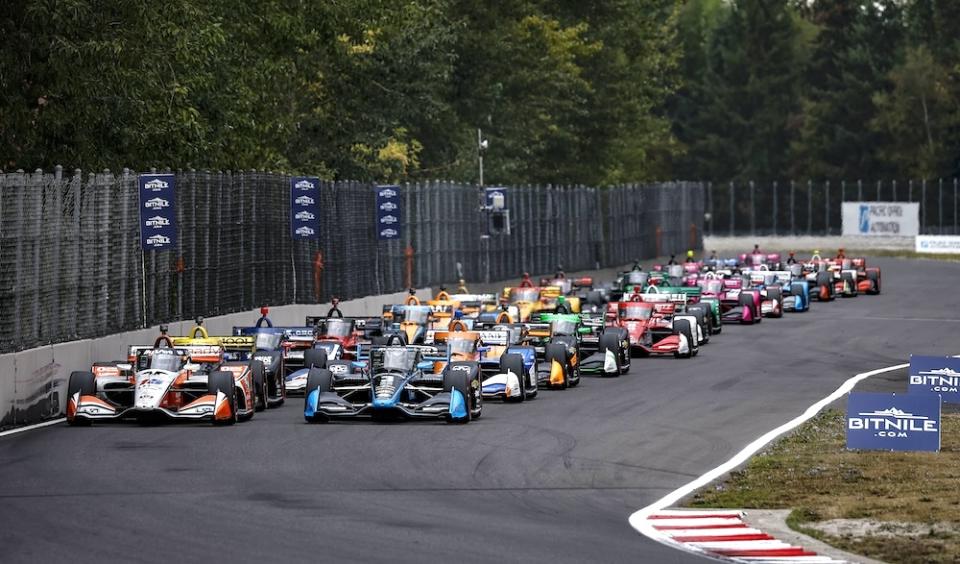IndyCar restarts charter talks

With its second attempt to form a charter system having failed late in 2023, Penske Entertainment says a third engagement with its IndyCar entrants, which took place earlier this week, ended in an encouraging manner.
At present, and in stark contrast to NASCAR and Formula 1, IndyCar team owners have no commodity to own or sell with their individual entries since the series does not have a formal financial structure in place for entrants to gain access to or take part in its series.
Company CEO Mark Miles expressed high hopes for the newest charter structure to reach the finish line, which is aimed for presentation to its teams at some point prior to the Indianapolis 500 in May.
“We did talk quite a bit about and there’s been a lot of phone calls already since yesterday, with team owners about our commitment to developing a charter system,” Miles said. “The way we explained it to them is that we’ve put out a couple of different concepts for charters in previous team owner meetings, and frankly, not been very close to consensus on what it might look like.
“So yesterday, we aired another high-level starting point for the concept of charters that maybe we’ll have more traction. And we’re going to work with a smaller group of team owners to get that developed — we’d like to see it fully developed and adopted before the 500 in coming weeks.”
As it was presented to the 11 teams represented on the call, no specific charter plans were laid out for the group, but Miles did provide some general thoughts on concepts for who might be included in the initial charter offering.
“Another element that we were talking about is we might start it [with] last year’s results, and the teams that we expect to be on the grid full-time this year, could be the initial charter members,” he said. “So if it’s going to be based on the composition of the grid at the beginning of this year for the IndyCar Series broadly, then the sooner we get we get it locked in, I think the more sense that will make.”
As RACER reported in August on the possibility of the Indy 500 having guaranteed starting spots for entries that have a charter, which drew the ire of many fans, and angered more in recent weeks when the same subject was raised, Penske Entertainment appears to have heard its fans and backed away from being as firm on the topic. IndyCar’s team owners, though, weren’t as keen on retreating from protected Indy 500 starting positions.
“So the discussion and our timing isn’t driven by trying to sort out exactly what happens on the grid for the Indy 500, although obviously, that’s going to be a point of discussion,” Miles said. “I’ll just tell you, in the proposal we put out yesterday, we said we want you to think about this without the assurance of charter members having automatic starting positions on the grid for the 500. That was what we aired. And of course, we immediately heard a lot of team owners saying, ‘Whoa, that’s really important [to us].’ So it’s a key discussion point for sure.”
RACER has independently confirmed other details of the newly-proposed charter structure, starting with car counts and how IndyCar’s decades-old Leaders Circle program, which pays guaranteed prize money to the top 22 finishers in the entrants’ championship, and would factor into the system.
Under the latest charter revision, the existing Leaders Circle program for the top 22 entrants from the previous season’s entrants’ standings would continue. In 2023, Penske Entertainment cut $150,000 from each Leaders Circle contract to increase its marketing budget, but that has been corrected for 2024 with each contract returning to its previous value of just over $1 million for each of the 22 entries.
The charter would keep paying the $1 million to the top 22 each season, and at least for the initial formation of the charter, between 25-26 entries could be accommodated. It’s here that having a charter and having a Leaders Circle contract can diverge.
In essence, only those teams with entries that are within the charter system would be eligible to earn one of the 22 annual Leaders Circle payouts. But with the payouts limited to the top 22 in entrants’ points, there would always be three or four cars with charters — whichever ones each year that place 23rd or worse — that do not qualify for the $1 million stipend.
With 27 full-time entries last season and 27 again this year, the charter system would — in its present state — encompass most of the cars on its grid, but not all. If, for whatever reason, a team with a charter wanted to leave the series, downsize its team, or expand its team, IndyCar’s charters would hold a certain value in the same way NASCAR’s Cup Series charters hold value as an asset to buy or sell.
From Wednesday’s meeting, no forecasted value for an IndyCar charter was presented by Penske Entertainment. A change in tact was also mentioned, this coming after the owners were reportedly asked in the meeting from late in 2023 to pay an upfront price of $1 million per charter. That request was shot down by all owners. As a result, no buy-in price for charter membership was proposed in the new meeting.
Closing with a return to guaranteed entries, Penske Entertainment did speak to issuing charters that locked its members into the 25-26 slots on every grid outside of the Indy 500. It’s unclear whether non-charter entries would be welcome at those events, but the concerns about ongoing increases in car counts and accommodating them within the available pit and paddock spaces at every venue was brought forth in the meeting.

 Yahoo Autos
Yahoo Autos 